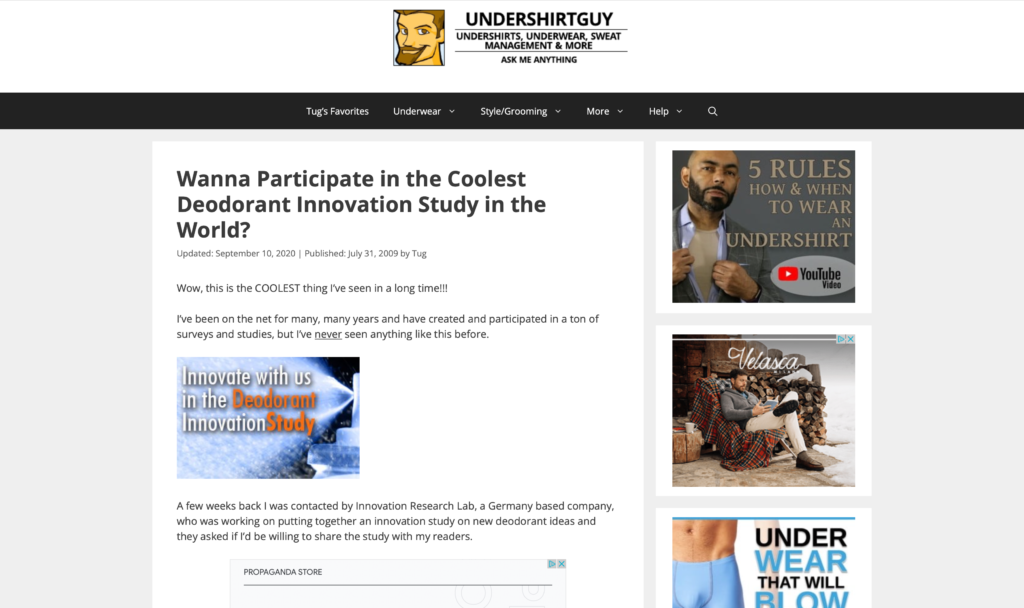Does a deodorant need any effort in product innovation? It’s almost a commodity. You have never noticed any difference among deodorants, haven’t you? Let’s try to challenge those assumptions.
Background: Company

Beiersdorf is a cosmetics company based in Hamburg, founded in 1882, with annual revenue of €7.5 billion and approximately 17 thousand staffed. Its most significant market is Europe, and its main product lines are three: Nivea (mass-market), Eucerin (derma cosmetics) and La Praire (premium products).
As you may wonder, Nivea is generating the largest share of revenue by targeting the mass market. Beiersdorf launched the product in 1911, and it was the first stable skin cream made of water in oil emulsion. The “white as snow” cream, as its name means, recently slightly reviewed its brand since many claimed that claiming that “white is pure” may sound racist.
The Deodorants Market
Nivea deodorants entered the market in 1951, ten years after the first patent. Nivea deodorant was able to stop the growth of bacteria that created sweat.
The global deodorant market Size was worth $22.54 billion in 2018 and is projected to reach $ 30.76 billion by 2026. Apart from Beiersfdorf, the other players are Unilever, Procter & Gamble, Henkel, Colgate-Palmolive, and L’Oreal.
As it happens often, initially, demand for those products was not that strong until aggressive advertising made normal talking in public about corporal respiration. From there, the key value driver of sales were hours of protection: in the 1980s, Unilever with Lexora got the 24hours protection mile, then in 2015, the landmark was at 72 or 96 hours.
At this point, the need for product differentiation was high. Many other customers’ needs must be addressed to climb the competition ladder, as Nivea did with skin regeneration, preparation for a closer shave and clothes staining.
Discovery
The first phase of product development for Nivea was consensing generic needs and trends into customer insights to draw a general picture. The insight could be used for future projects only if it passed the so-called “SEED tests“, which means that the insight had to:
- Resanote with the customer (spark recognition)
- Be easy to understand
- start from what the customer has done (echo and extrapolate)
- Direct to a clear direction.
Using surveys, group discussions, and interviews, brand experts also validate the insight. Moreover, the researchers started observing the customer in “bathroom studies”, test rooms that looked like a typical bathroom.
How to prioritise ideas? The criteria used are a strategic fit, competitive advantage, customer fit and financial potential.
Problem Ownership

Identifying the need was not enough: it was too hard to understand who was the “owner of the problem” in the case of clothes staying. Body fats, cleaning detergent, clothes materials and deodorant contribute all to the issue, so other competitors with more product lines covering the issue were “supposed” to intervene. Luckily, not everyone agreed and Dr Stefan Biel, scientist and leader of Beiersdorf’s Deodorant Prototyping research group, worked on that in his spare time.
Stefan Biel worked on the problem with a series of unusual approaches, given that typical interview research would have shown anything useful.
Product Understanding and Development
At first, he started collecting worn deodorant-stained shirts from the Beiersdorf intranet. He also got interested in “netnography“, i.e.the study of social interaction in contemporary digital communications contexts. More practically, he started researching sites such as bodybuilding.com, motor-talk.de, and askmehelpdesk.com with a passive approach, passively observing user-generated content. The process had the advantage of a large sample and low costs of running. Thanks to the study, he observed that people had identified eight types of stains and often found deodorants guilty.
Having identified who was responsible according to the customer was not enough for Biel, and he decided to involve the users for solution validation: they created online elements in which it was possible to express many preferences regarding concepts. More than 2000 users marked the different ideas as “develop further”, “neutral”, or “trash”. You can still find it.

Finally, ten years after the project, anti-stain Nivea products are flourishing.
Apply the process everywhere
You may feel like the story is industry-specific, and maybe it didn’t happen to you to create skincare products for a multinational reality. However, I believe there are many teaching you can apply in any problem management/innovation context:
- Don’t fall in love with the solution before identifying the problem. You should not start solving your question with a problem, but before you try to understand how the customer perceives the situation, transform data into valuable insights and identify who’s owning the problem.
- Thanks to the internet, you don’t need a multinational company budget to validate your solutions: for example, if you have an idea in your pocket, create a landing page and check how the user reacts to it.
- Research needs in unbiased environments: firms face the problem of turning customer inputs into a new product, avoiding any direct question that would induce any bias. It turns out that customer is very clear about their needs (in terms of feeling them, articulation is another kind of problem), but they are not good at solving them. That’s why it’s a good idea to go beyond the classic user interview question and design experiments that look like everyday life.
Want to know more about this problem-solving approach and how it could help you win a hot dog eating contest? I wrote an article about that.
Sources, References, and extra food for thoughts
- Nivea removes ‘white is purity’ deodorant advert as ‘racist’ https://www.bbc.com/news/world-europe-39489967
- Beiersdorf. “Let’s Create Together.” August 22, 2018. https://www.beiersdorf.com/newsroom/press-news/local/en/all-news/2018/08/22-lets-create-together, accessed November 2018.
- Regan, Charlie. “Nivea’s Invisible Black and White – Social Media Synergy.” Social Media for Business Performance, February 16, 2015. https://smbp.uwaterloo.ca/2015/02/niveas-invisible-black-white-social-media-synergy/, accessed November 2018.
- Beiersdorf. “Beiersdorf Raised Open Innovation to a New Level.” December 22, 2016. https://www.beiersdorf.com/newsroom/press-news/all-news/2017/01/09-beiersdorf-raised-open-innovation-to-a-new-level, accessed November 2018.
- Why Nivea is Expanding Crowdsourcing for New Innovation https://www.gcimagazine.com/brands-products/news/news/21868642/why-nivea-is-expanding-crowdsourcing-for-new-innovation

Leave a Reply